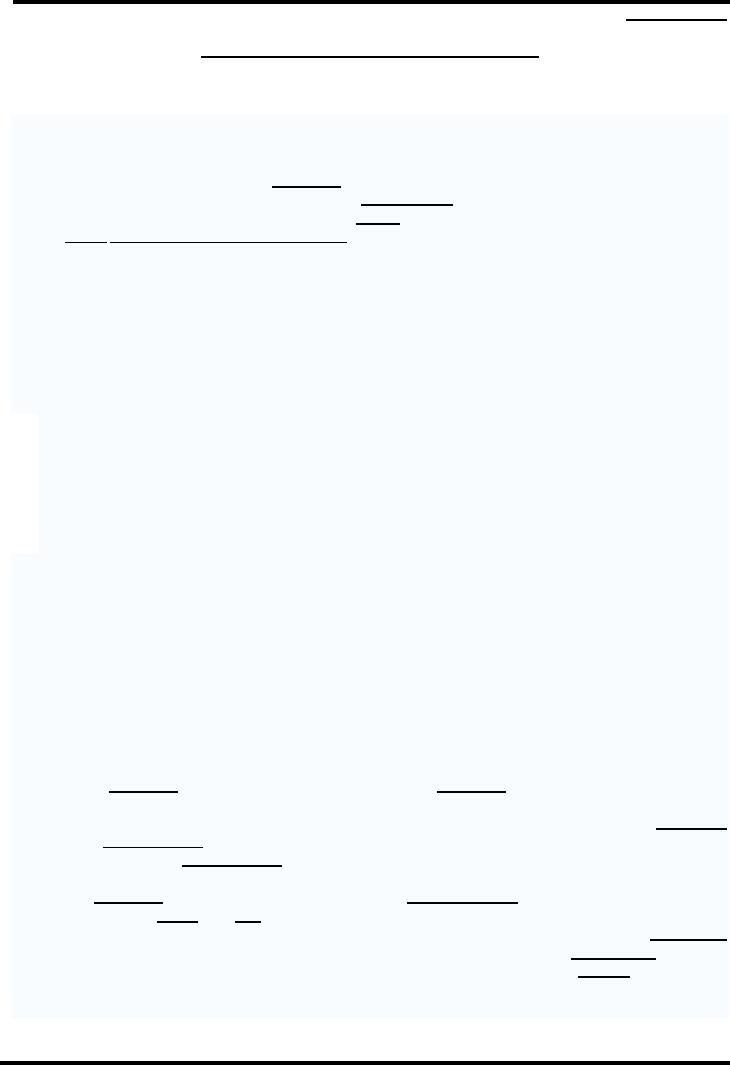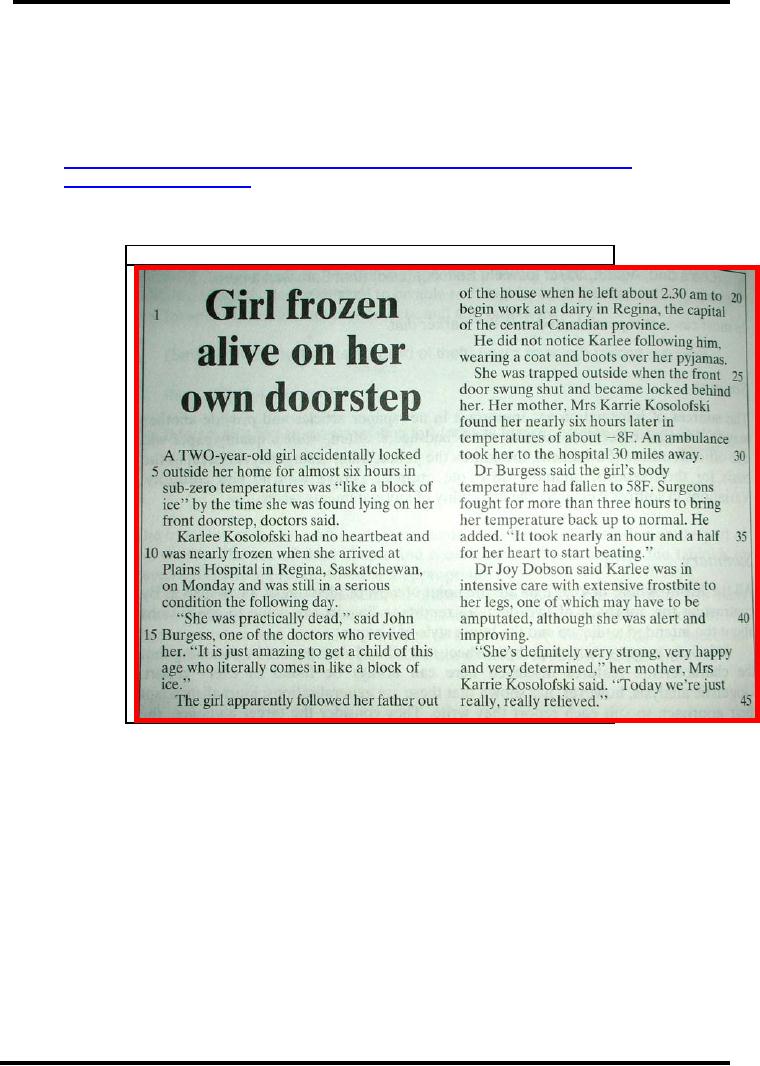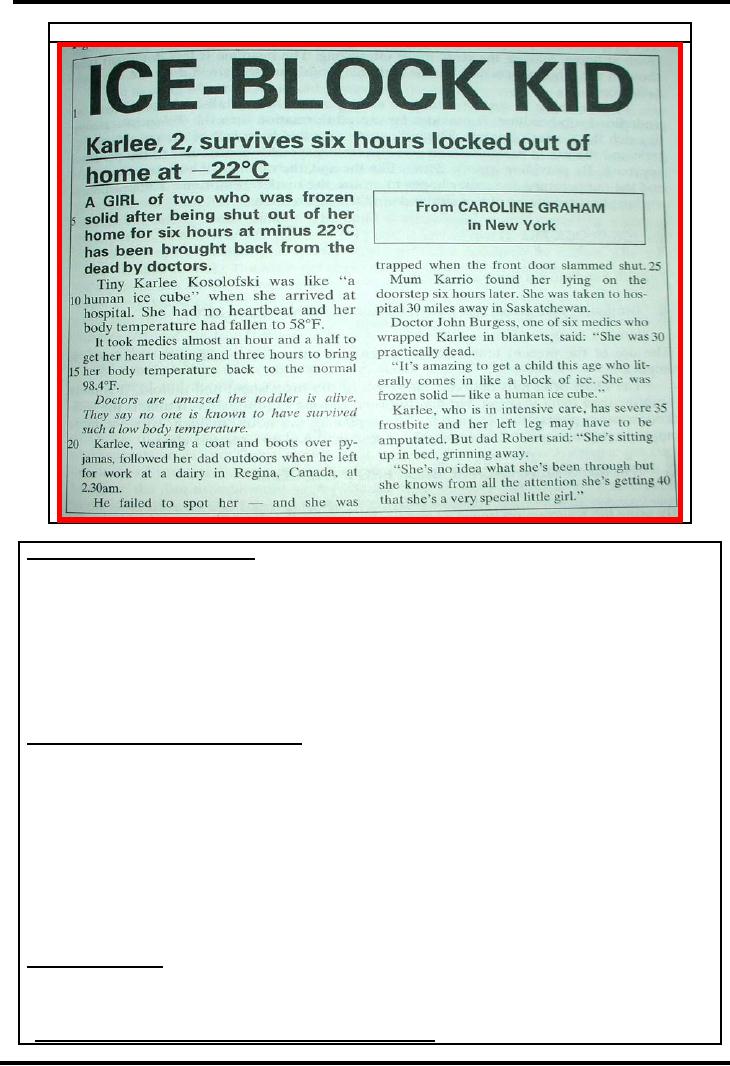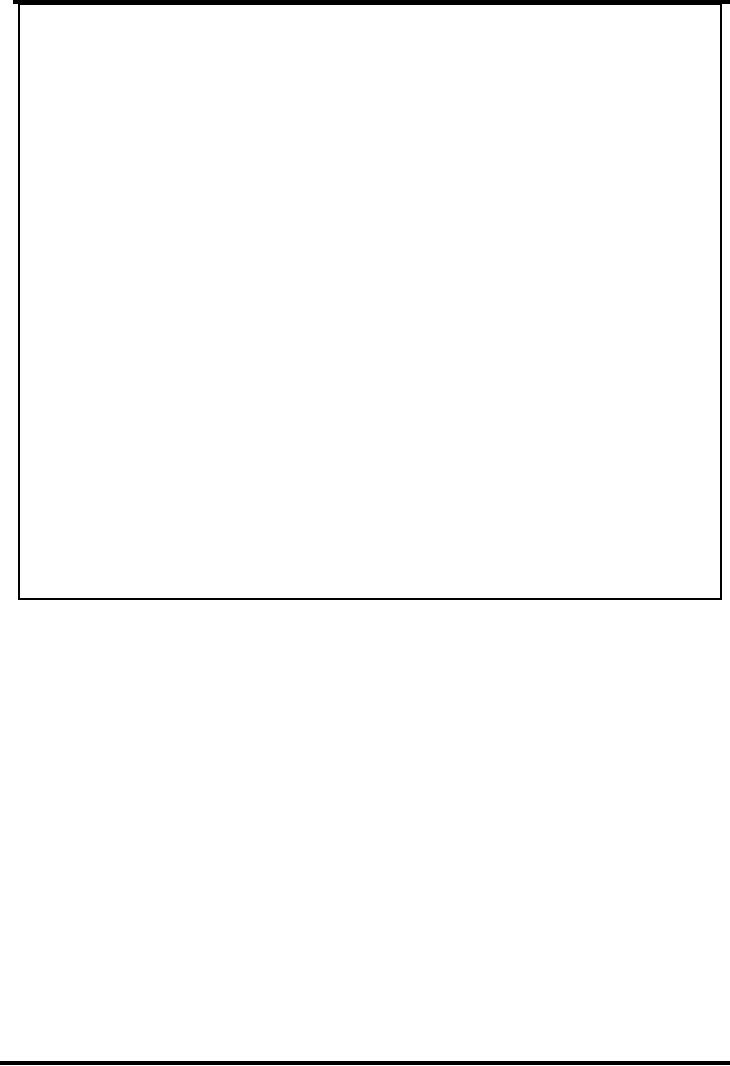 |
THE LANGUAGE OF THE NEWSPAPERS II:BROADSHEET NEWSPAPER |
| << PARTS OF A NEWSPAPER:Box-out, By-line, Caption, Exclusive, Feature |
| News Writing and Style I:WHAT TO LOOK FOR IN A NEWSPAPER >> |

Journalistic
Writing MCM310
VU
LECTURE
33
THE
LANGUAGE OF THE NEWSPAPERS II
The
newspapers can be divided
into two general
categories:
TABLOIDS
and BROADSHEETS
BROADSHEET
NEWSPAPER:
Broadsheet
is the
largest of the various newspaper formats
and is characterized by long vertical
pages (typically
22
inches or more). The term
derives from types of
popular prints usually just
of a single sheet, sold on
the
streets
and containing various types
of matter, from ballads to political
satire. The first broadsheet
newspaper
was
the Dutch Courante uyt Italien,
Duytslandt, &c. published in
1618.
Many
broadsheets measure roughly 29½ by 23½
inches (74.9 cm × 59.7 cm)
per full broadsheet spread,
twice
the
size of a standard tabloid.
Australian and New Zealand
broadsheets always have a
paper size of A1 per
spread
(84.1cm by 59.4cm).
In
the United States the traditional
dimensions for the front
page half of a broadsheet
are 15 inches wide by
22¾
inches long. However in
efforts to save newsprint costs
many U.S. newspapers
(including The Wall
Street
Journal)
are downsizing to 12 inches wide by 22¾
inches long for a folded
page.
The
two versions of the broadsheet
are:
·
Full
broadsheet - The
full broadsheet typically is
folded vertically in half so that it
forms four pages
(the
front page front and
back and the back page
front and back). The
four pages are called a
spread.
Inside
broadsheets are nested
accordingly.
·
Half
broadsheet - The
half broadsheet is usually an
inside page that is not
folded vertically and
just
includes
a front and back.
In
uncommon instances an entire newspaper
can be a two-page half
broadsheet or four-page full
broadsheet.
Totally
self-contained advertising circulars inserted in a
newspaper in the same format
are referred to as
broadsheets.
Broadsheets
typically are also folded
horizontally in half to accommodate
newsstand display space.
The
horizontal
fold however does not affect the
page numbers and the content
remains vertical. The
most
important
newspaper stories are placed
"above the (horizontal) fold." This
contrasts with tabloids
which
typically
do not have a horizontal
fold (although tabloids usually
have the four pages to a
sheet spread format).
Historically,
broadsheets were developed when in
1712 a tax was placed on
British newspapers based on
the
number
of their pages.
TABLOID
NEWSPAPER:
A
tabloid
is a
newspaper industry term which refers to a
smaller newspaper format per
spread; to a weekly or
semi-weekly
alternative newspaper that focuses on
local-interest stories and entertainment,
often distributed for
free
(often in a smaller, tabloid-sized
newspaper format); or to a newspaper
that tends to emphasize
sensational
crime
stories, gossip columns
repeating scandalous innuendos about the
personal lives of celebrities
and sports
stars,
and other so-called "junk
food news" (often in a
smaller, tabloid-sized newspaper
format).
The
tabloid newspaper format is particularly
popular in the United Kingdom. A
tabloid format newspaper
is
roughly
23½ by 14¾ inches (597 mm × 375
mm) per spread. This is the
smaller of two standard
newspaper
sizes;
the larger newspapers, traditionally
associated with 'higher-quality' journalism,
are called
broadsheets
(although
some British 'quality'
papers have recently adopted the
tabloid format; The
Guardian being
the
exception
by adopting the Berliner format). A
third major format for
newspapers is the Berliner, which is
sized
between
the tabloid and the
broadsheet.
125

Journalistic
Writing MCM310
VU
Examples
of Newspapers:
Broadsheet
Newspapers
Tabloid
Newspapers
The
Express
The
Guardian
The
Mail
The
Independent
The
Sun
The
Telegraph
The
Mirror
The
Times
The
Star
The
Financial Times
Editorial
Policy
Tabloids
and broadsheets do not look
different by accident. Each
paper is trying to appeal to
whom it sees as
its
readership. The readers of the
broadsheets don't generally
read tabloids and vice
versa. Tabloid stories
are
generally
shorter, while broadsheet stories
are more in-depth. Both
are written in a particular
style.
It
is the job of the editor, and the
various sub-editors, to know what the
paper should look and feel
like and
then
to make sure that only
stories that suit the style
of the paper are actually
published.
Editorial
Choice
The
amount of 'hard news' that a paper
decides to print is determined by the
editorial policy of the
paper.
Tabloids
do feature political stories,
though they tend to prefer to focus on
personalities of the politicians
rather
than the actual issues that
may be relevant.
There
is likely to be a much closer
correlation between the news in the
broadsheets and the TV news. In
most
cases
the lead story will be the
same. The order of importance in
which the news has been
ranked is also likely
to
be similar in the case of TV news
and the broadsheets.
One
picture is worth a thousand
words...
Generally
speaking, tabloids make far
greater use of pictures than
the broadsheets do. The
total area of the
paper
that is given over to pictures is
likely to be far greater in the
tabloid - perhaps 25% as opposed to
10%.
You
can quickly estimate these
figures for yourself.
The
types of picture are also
different. The popular tabloids
tend to use pictures to
liven up sensational
stories:
they
are unlikely to have many
photographs of politicians making speeches. One of the
main differences in
style
between
tabloid
and
broadsheet
is
this
use
of
images.
This
is a complex area. Both types of
paper are good at choosing
and displaying the images that they
think their
readers
would like to see. It is not
only the tabloids that use
images effectively. Broadsheets
often use
photographs
in striking ways, though they
are less likely to cover
celebrity scandal stories.
Language
This
is probably the most difficult
area of all to define. Much of the
work on this will have to
come from your
own
reading of newspapers. Below are
some general pointers as to how to
analyze the language of
newspapers.
Tabloids
often use subjective
language (subjective means
allowing personal opinion to
dominate).
Broadsheets
tend to make greater use of
objective language (objective means
dealing with facts in a
detached
manner).
Opinion
tends to be acknowledged and
kept separate from fact e.g.
'Some people felt the woman
was
unbalanced.'
Using
language subjectively
is a common
trait of the tabloid. Deliberately using
emotive
language
(language
designed
to stir up the emotions) is a feature found commonly
in tabloids.
Opinion
might be passed off as being fact in
order to persuade you: e.g.
'The woman's mad - she
should be
locked
up.'
Such
features of language are to be
found throughout articles as
well as in headlines. Weighing up the
balance
between
subjective and objective language is a
useful way to look at the
approach that a newspaper
has to
news.
Of
course not all stories in
any newspaper are entirely
serious. There are times
when humor assists the
telling
of
a story. It is for you to judge whether
this is a good ploy to use on
all occasions.
126

Journalistic
Writing MCM310
VU
Recap
You
should now feel confident about
explaining:
The
differences between tabloid
and broadsheet newspapers
(size, style and
content)
How
editorial policy affects
newspapers.
The
use of language and pictures
in the two types of
paper
The
use of language and pictures
in the two types of
paper
How
tabloid and broadsheets
cover the same story
differently
Source:
http://www.bbc.co.uk/education/asguru/generalstudies/culture/04news/news01.shtml
Source:
http://en.wikipedia.org/wiki
IMPORTANT:
Let's analyse the language
of the two
newspapers.
PAPER
1: A Broadsheet Report
127

Journalistic
Writing MCM310
VU
PAPER
2: A Tabloid Report
An
Example Language Analysis:
Both
of these two news articles
cover the same basic facts:
the age of the child; the temperatures
outside;
the
length of time she spent on the doorstep;
the child's clothing; and so
on.
The
difference between the reports emerges in the
way they treat their subject
matter.
He
headlines immediately demonstrate the
variation in approach of a quality
broadsheet and a
popular
tabloid.
The
broadsheet newspaper uses a
straightforward, factual headline which
is simple and yet still
dramatic. It
is
a simple sentence in
structure:
"Girl
frozen alive on her own
doorstep"
The
prepositional phrase functioning as an
adverbial highlights the fact that this
too place at home,
making
the
story more interesting. The
headline is less dominant
than that of in the other
paper (paper 2) ad,
in
line
with the papers house style
I does not use
capitalization.
The
report in tabloid (paper2)
aims to attract attention
and uses both a capitalized
headline and an
underlined
sub-headline. It provides far more
information than the broadsheet
(Paper 1), aiming to
catch
the
reader's interest. The
colloquial noun Kid
is typical of the
paper' chatty style and the
use of parenthesis
to
give the child's age also contribute to
the personal approach. By providing
specific details like the
age,
the
number of hours spent outside
and the temperature, the paper
hopes to arouse the reader's
emotions.
The
headline is a noun phrase
made up of a compound modifier and
noun.
"ICE
BLICK KID"
The
sub- headline is a complex
sentence:
"Karlee,
2, survives six hours locked
out of home at -22°C"
128

Journalistic
Writing MCM310
VU
The
use of the present tense
creates a sense of immediacy, adding to
the dramatic impact.
The
spreadsheet (Paper 1) uses
modifiers
which
give the reader precise
information:
Serious
condition (lines 12-13); six hours
(line 5); extensive
frostbite (line
38)
The
tabloid (Paper 2) uses noun
phrases in which the modifiers give the
reader details about the
child.
They
are emotive, but not particularly
sensational:
Low
body temperature (line 19);
severe frostbite (line
35-6)
The
naming of the participants and
places
tells
the reader something about the nature of
broadsheets
and
tabloids. The parents are
named in different ways by the
both of these papers. The
spreadsheet (paper
1)
uses the formal Mrs
Karrie Kasalofski whereas
the tabloid (paper 2) uses
informal ways like Mum
Karrie and
Dad
Robert. For
child, the broadsheet uses a
two-year-old
girl whereas
the tabloid uses the more
informal
words,
kid,
toddler and
tiny
to how
more vulnerability and thus
sensationalises.
The
connotations
of
words add to the effects
created. The lexis of the
broadsheet are more formal
and
therefore
does not rely on wider associations of
individual words to create a
sense of drama. The
tabloid
(paper
2) uses the word amazed
to
show an extraordinary event.
The
adverbials
in
these reports are quite similar,
many providing information
about the length of time the
child
spent outside and the
place.
Marked
themes are
used to dramatise the narrative of the action
story.
The
passive voice is used to suggest
that no one can really be
blamed for this
accident.
The
direct speech is important in this kind
of story because it adds a
personal feeling to the drama.
Both
these
reports quote the doctors and their
exact words give authority to the
statements.
Action
stories have chronological structure
and this is apparent
here.
And,
this ends the analysis.
129
Table of Contents:
- INTRODUCTION TO JOURNALISTIC WRITING:Practical, THINGS TO KNOW
- QUALITIES OF GOOD WRITERS
- QUALITIES OF GOOD WRITERS
- QUALITIES OF GOOD WRITING:Achieve appropriate readability:
- QUALITIES OF GOOD WRITING:Be concise, Be creative, Be correct
- THE PROCESS OF WRITING:INVENTION, WHEN YOU START TO WRITE
- THE PROCESS OF WRITING II:ORGANIZING, DRAFTING, REVISING
- ALL ABOUT WORDS:HOW WORDS ARE FORMED?:SUFFIXES
- DICTIONARY-A WRITER’S LANGUAGE TOOL:KINDS OF INFORMATION
- PARTS OF SPEECH:Noun Gender, Noun Plurals, Countable Nouns
- BASIC CLAUSE PATTERNS
- ACTIVE AND PASSSIVE VOICE
- MODIFIERS AND SENTENCE TYPES:COMPOUND SENTENCES
- REPORTED SPEECH:Indirect Questions, Direct commands
- GRAMMATICAL SENTENCE – ISSUES:SUBJECT-VERB AGREEMENT
- GRAMMATICAL SENTENCE – ISSUES II:SENTENCE FRAGMENTS
- EFFECTIVE SENTENCE:PARALLELISM, NEEDED WORDS, SHIFTS
- STYLE: GUIDELINE AND PITFALLS I:COLLOQUIAL VS FORMAL, CIRCUMLOCUTION
- STYLE: GUIDELINE AND PITFALLS II:AMBIGUITY, REDUNDANCY, EUPHEMISM:
- PARAGRAPH WRITING: TYPES AND TECHNIQUES:STRUCTURE
- PARAGRAPH WRITING: TYPES AND TECHNIQUES:Putting on Our Play
- ESSAY WRITING:VARIOUS STRATEGIES FOR ESSAYS, PROMPTS
- SIGNAL WORDS:Non word Emphasis Signals
- EXPOSITORY WRITING:LOGICAL FALLACIES, APPEAL TO EMOTION
- THE WRITING STYLES: REPORT and NARRATIVE WRITING, SHORT REPORTS
- THE WRITING STYLES: DESCRIPTIVE AND PERSUASIVE WRITINGS, Observation
- RESEARCH WRITING AND DOCUMNETING SOURCES:Handling Long Quotations
- Summary and Précis Writing:CHARACTERISTICS OF GOOD SUMMARY
- Punctuation:THE PERIOD, THE COMMA, THE SEMICOLON, THE COLON
- MECHANICS:ABBREVIATIONS, NUMBERS, SPELLING, THE HYPHEN
- READING SKILLS FOR WRITERS:EDUCATED READING, STEPS
- PARTS OF A NEWSPAPER:Box-out, By-line, Caption, Exclusive, Feature
- THE LANGUAGE OF THE NEWSPAPERS II:BROADSHEET NEWSPAPER
- News Writing and Style I:WHAT TO LOOK FOR IN A NEWSPAPER
- NEWS WRITING II:Accuracy, Clarity, Style, Qualities of Effective Leads
- EDITORIAL WRITING:WRITING AN EDITORIAL:STRUCTURING AN EDITORIAL
- WRITING FEATURES:GENERATING FEATURE STORY IDEAS
- WRITING COLUMNS:Column and a news report, Purpose, Audience
- WRITING ARTICLES FOR NEWSPAPERS:The Heading, The Lead
- WRITING ANALYSIS:purpose, scope, method, results, recommendations
- LETTERS TO EDITORS:Four important aspects about letters, Organizing letters
- BROADCAST AND WEB NEWS WRITING:WRITE CONCISELY, BROADCAST STYLE
- WRITING PRESS RELEASE, REVIEWS AND OBITUARIES:Summary of Content:
- THE ART OF INTERVIEWINGS
- FINAL THOUGHTS:Practical, Job-Related, Social, Stimulating, Therapeutic